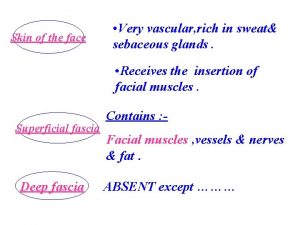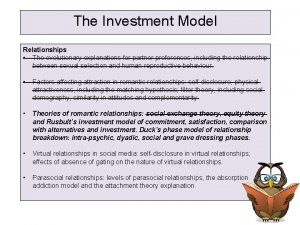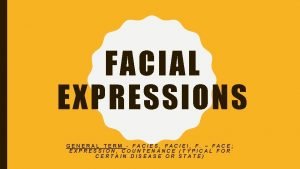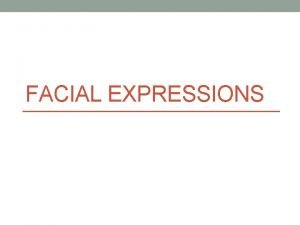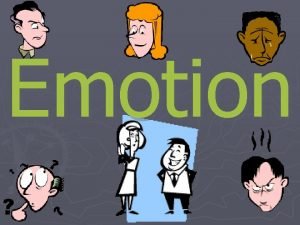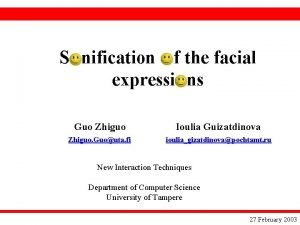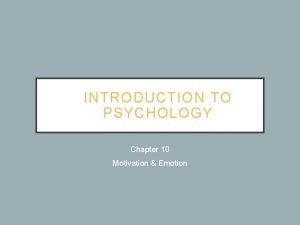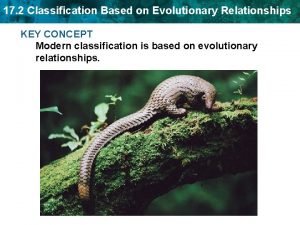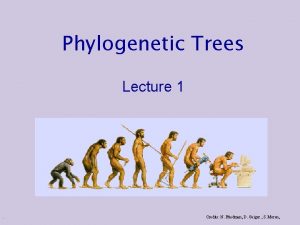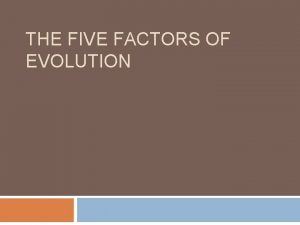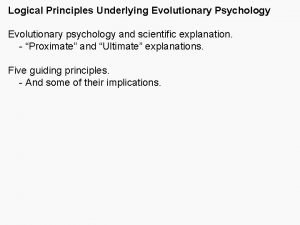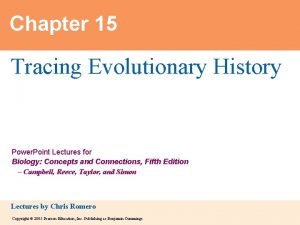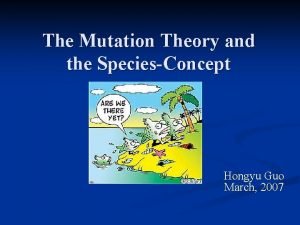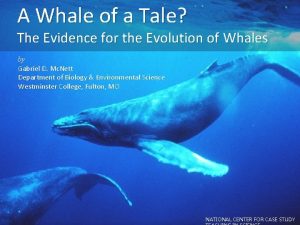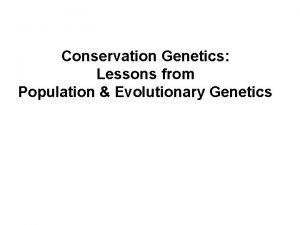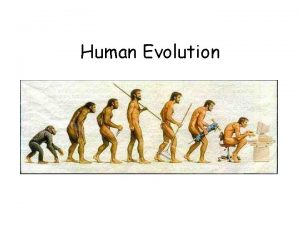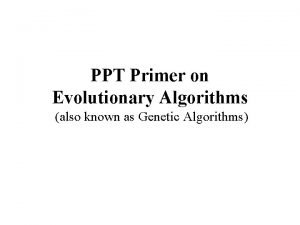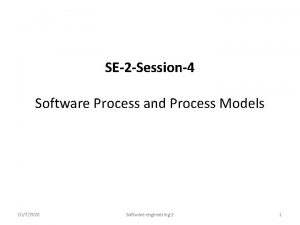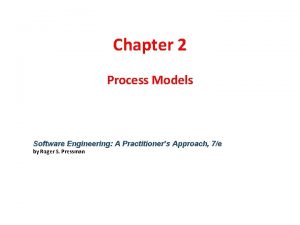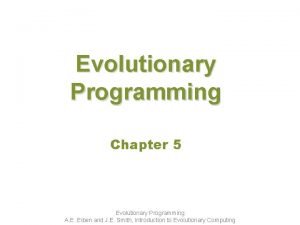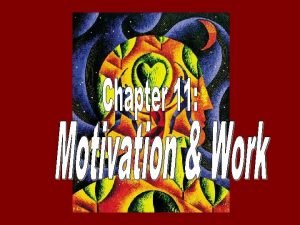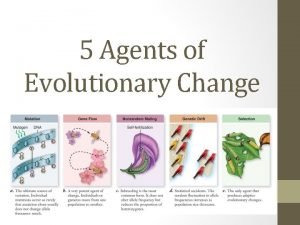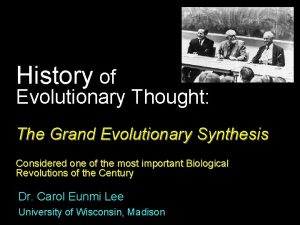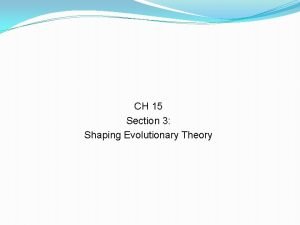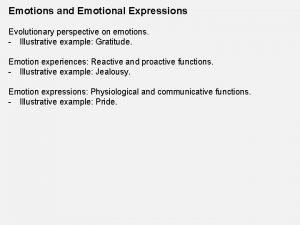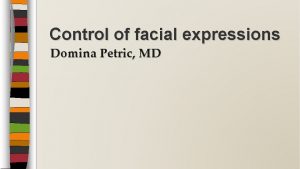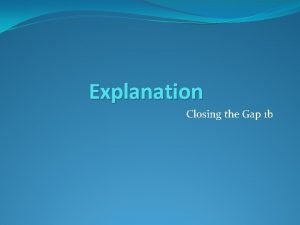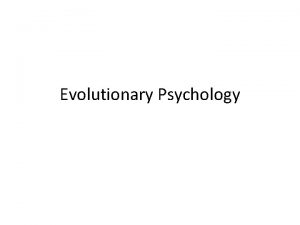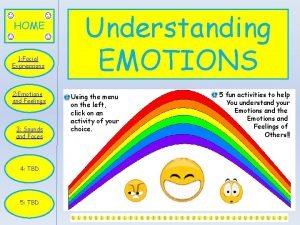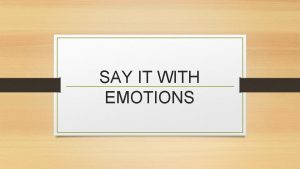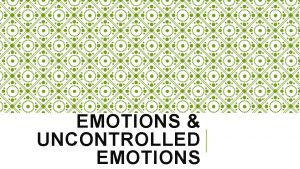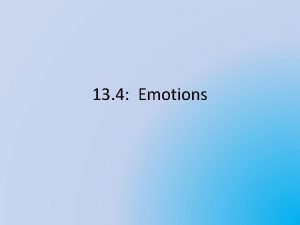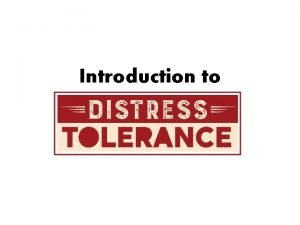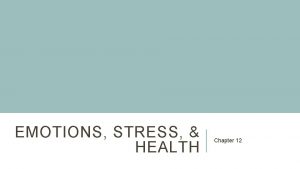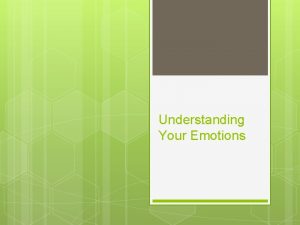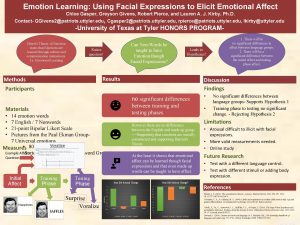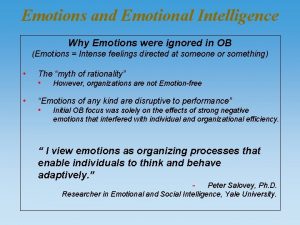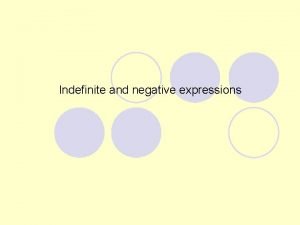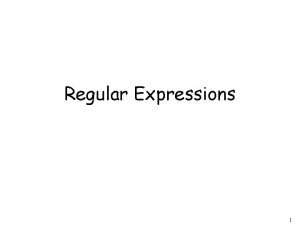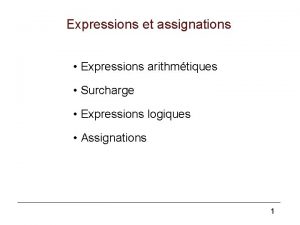Emotions emotional facial expressions evolutionary explanation Emotions emotional










































- Slides: 42

Emotions � emotional facial expressions ◦ evolutionary explanation

Emotions � emotional facial expressions ◦ evolutionary explanation � role of right hemisphere

Emotions � emotional facial expressions ◦ evolutionary explanation � role of right hemisphere ◦ recognition of emotion brain damage – functional imaging studies ◦ display of emotions brain damage functional imaging studies ◦ chimera

Chimeras of chimps in various moods

Other interesting data � left side of face even shows emotion sooner than right side

Copyright © Allyn & Bacon 2007

Emotions �emotional facial expressions ◦ evolutionary explanation �role of right hemisphere ◦ recognition of emotion ◦ display of emotions ◦ chimera �brain damaged humans

brain regions involved in emotion � limbic system- ◦ components of limbic system- includes hypothalamus, hippocampus, amygdala, olfactory bulbs, septum � sits within the temporal lobe ◦ temporal lobe epilepsy


Stress � What is it? ◦ stress is the nonspecific response of the body to any demand placed on it � What are some of the variables that contribute to how we respond to stress?

Two systems activated during stress and emotion 1. Sympathetic Nervous system ◦ activates adrenal glands to release E, NE, and other catecholamines into blood



Are there consequences of repeated sympathetic activation? � perhaps………


As a side note – sympathetic activation is also an indicator of arousal � Physiological � lie measures of arousal detector tests

What do they measure? Are there problems with these tests?

2. HPA Axis - (hypothalamic-pituitaryadrenal) axis causes the release of “stress” hormones (corticosteroids) cortisol - in humans corticosterone - in rats


negative feedback loop

Overactivation of either system can have negative (hypothalamus) consequences

Psychosomatic Illnesses � real illnesses that are exacerbated by stress- ◦ these can be potentially life threatening

Psychosomatic Illnesses � ulcers � heart disease � asthma � various skin conditions -

Fields of interest � Behavioral medicine � Psychoneuroimmunology

Does stress have adverse effects on the CNS? � Sapolsky ◦ vervet monkeys - 1989

Eight vervet monkeys, housed in a primate center in Kenya, died spontaneously from 1964 to 1966, were found at necropsy to have multiple gastric ulcers; a retrospective, neuropathological study was then done of this opportunistic population. Compared with controls euthanized for other research purposes, ulcerated monkeys had marked hippocampal degeneration that was apparent both quantitatively and qualitatively, and both ultrastructurally and on the lightmicroscopic level. Minimal damage occurred outside the hippocampus.


Does stress have adverse effects on the CNS? � Sapolsky ◦ vervet monkeys - 1989 gastric ulcers, overactive adrenal gland, degeneration and depletion of hippocampal neurons

What about chronic stress in humans and CNS? � Cushings Syndrome - ◦ increased glucocorticoid release (can be reversed with treatment) � PTSD - � Depressed patients


How might this happen? � Increased cortisol or corticosterone ◦ increase Ca+2 influx increased risk of overexcitation

Sapolsky � Rat studies -


What about stress and immune function?

Can stress disrupt immune function? � Yes- clinical data and animal studies

Do these changes following acute stressors impact health?

What about more chronic stressors? � Chronic stress situations ◦ examples: Is this associated with increased susceptibility to disease?



Chronic stress affects immune response in terms of illness incidence and recovery

Role of Optimism � Segerstrom

Role of Optimism � Segerstrom ◦ law students during their first semester ◦ optimism associated with increased n of helper T cells increased natural killer cell activity
 Face veins and arteries
Face veins and arteries The investment model of relationships
The investment model of relationships Facies hectica
Facies hectica Why are facial expressions important
Why are facial expressions important Unconscious facial expressions
Unconscious facial expressions Facial expressions are a part of what mcq
Facial expressions are a part of what mcq Facial expressions
Facial expressions Facial expression recognition
Facial expression recognition Chapter 10 motivation and emotion
Chapter 10 motivation and emotion Iyifn
Iyifn Infants display a wide range of emotional expressions
Infants display a wide range of emotional expressions Perbedaan (planning mode) dan (evolutionary mode)
Perbedaan (planning mode) dan (evolutionary mode) Classification is based on evolutionary relationships
Classification is based on evolutionary relationships Golg11
Golg11 18-2 modern evolutionary classification
18-2 modern evolutionary classification Chapter 15 darwin's theory of evolution section 15-1
Chapter 15 darwin's theory of evolution section 15-1 Primate tree
Primate tree Evolutionary theory of motivation
Evolutionary theory of motivation What is genetic drift
What is genetic drift Evolutionary psychology
Evolutionary psychology Evolutionary psychology questions
Evolutionary psychology questions Chapter 15 tracing evolutionary history
Chapter 15 tracing evolutionary history Clicker fungus
Clicker fungus Modern evolutionary synthesis
Modern evolutionary synthesis Whale evolutionary tree
Whale evolutionary tree Evolutionary genetics
Evolutionary genetics Evolutionary anthropology
Evolutionary anthropology 7 perspectives of psychology
7 perspectives of psychology Evolution of logistics ppt
Evolution of logistics ppt Evolutionary software process models
Evolutionary software process models Generic process model in software engineering
Generic process model in software engineering Evolutionary programming
Evolutionary programming Classification based on evolutionary relationships
Classification based on evolutionary relationships Coelom
Coelom Scientific psychology definition
Scientific psychology definition Whale evolutionary tree
Whale evolutionary tree Founder effect vs gene flow
Founder effect vs gene flow Refractory period men
Refractory period men Evolutionary maintenance
Evolutionary maintenance 5 agents of evolutionary change
5 agents of evolutionary change History of evolutionary thought
History of evolutionary thought Chapter 15 section 3 shaping evolutionary theory
Chapter 15 section 3 shaping evolutionary theory Evolutionary delivery
Evolutionary delivery
